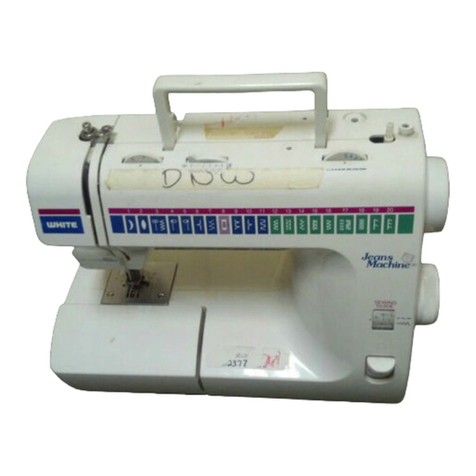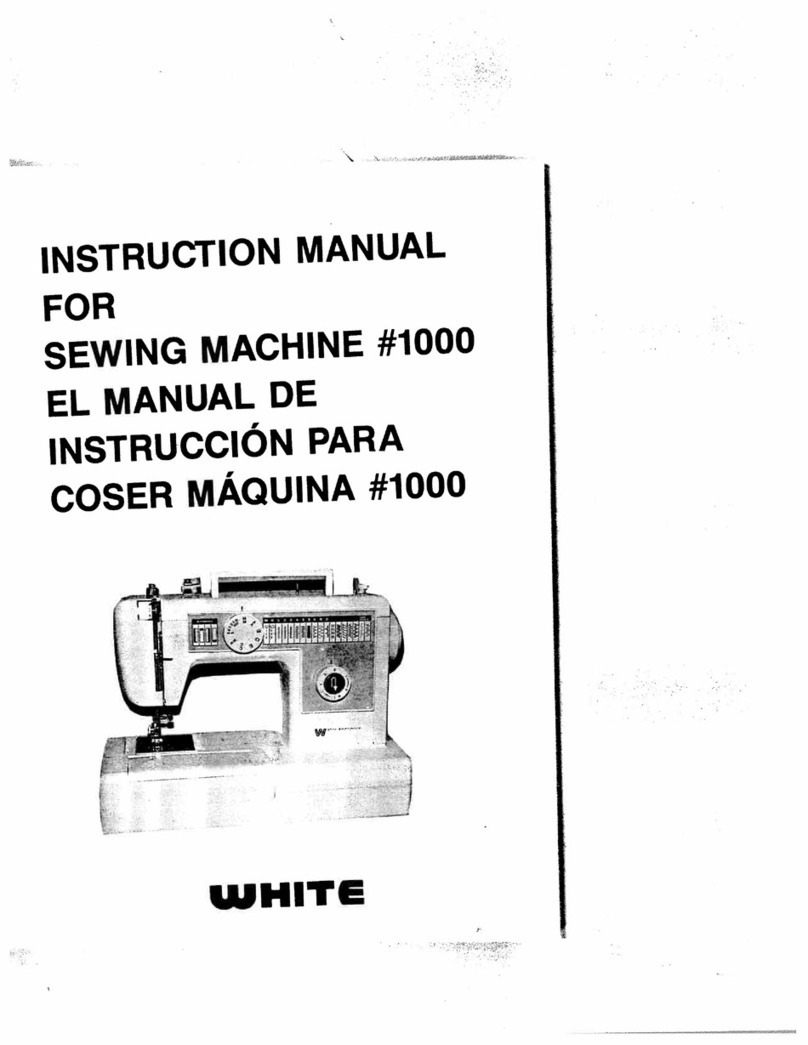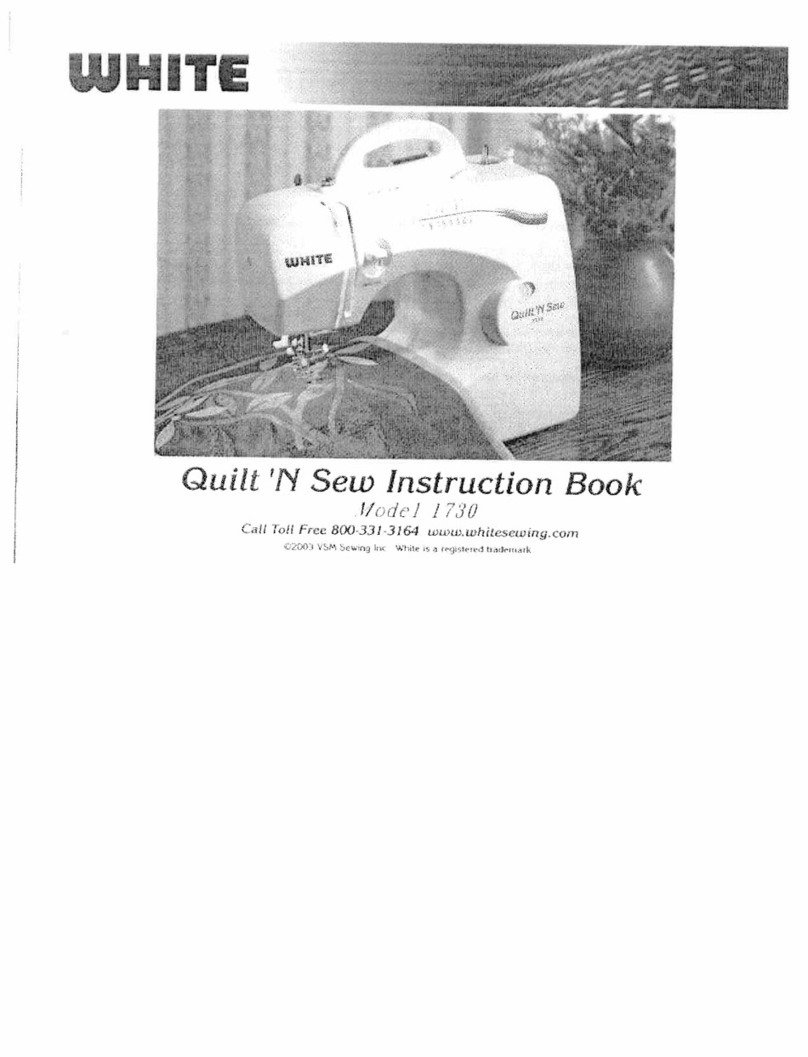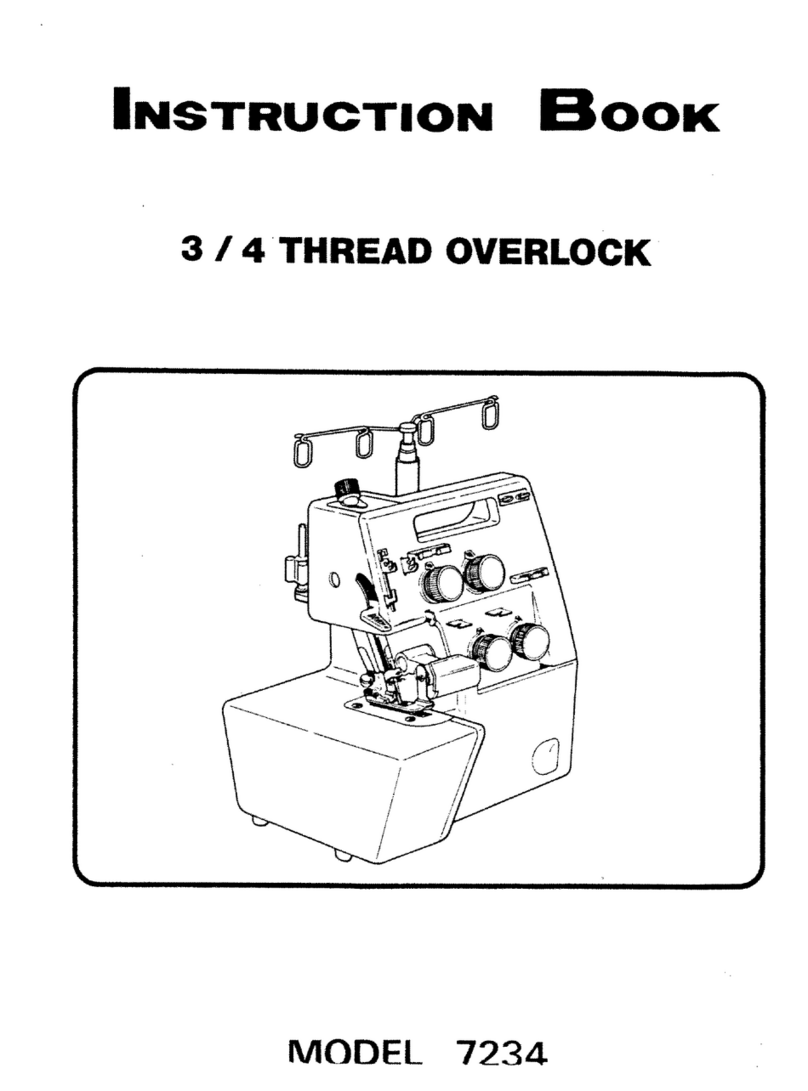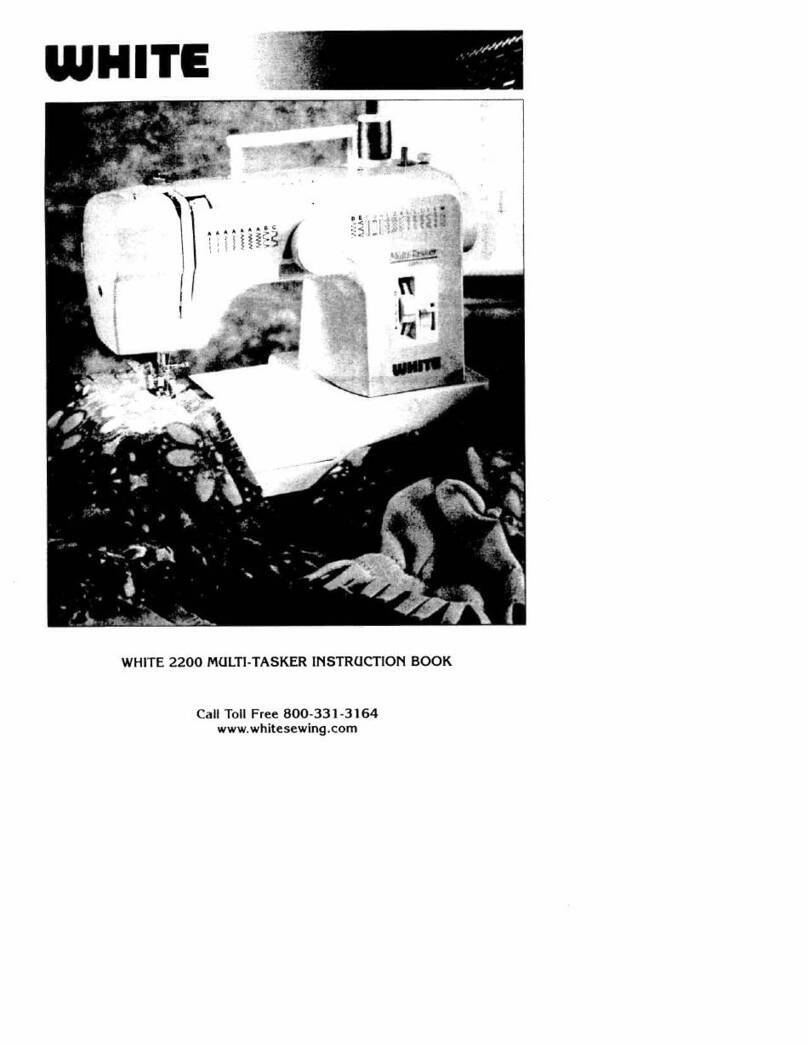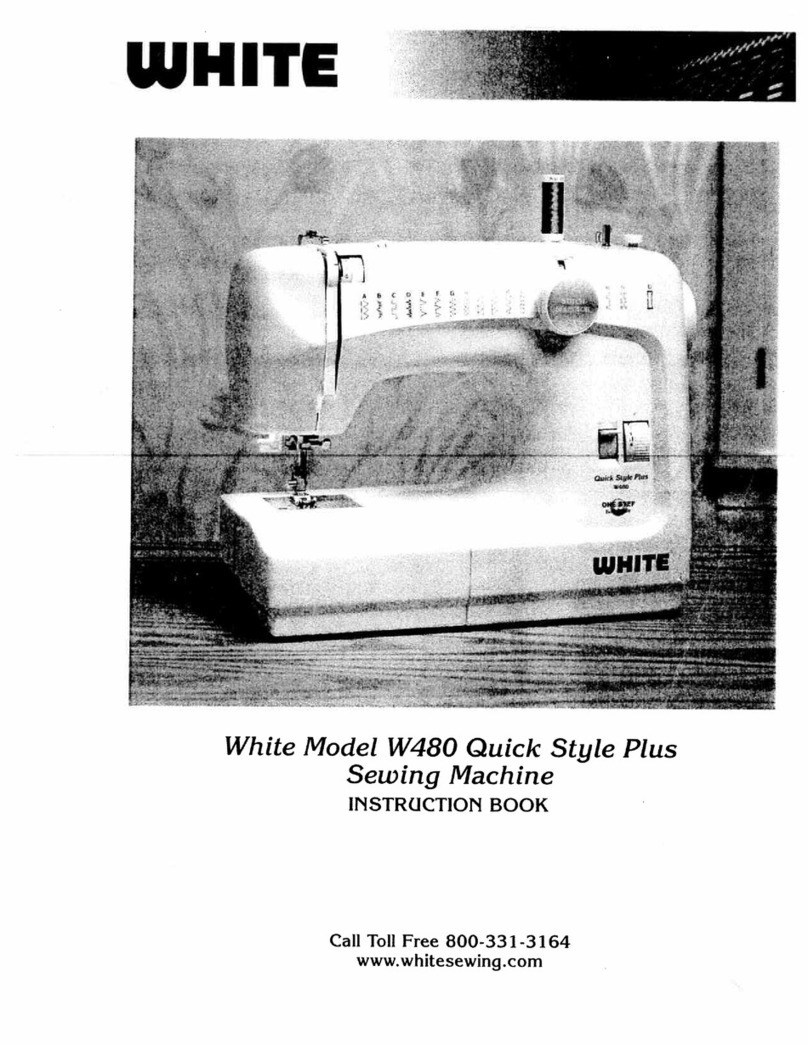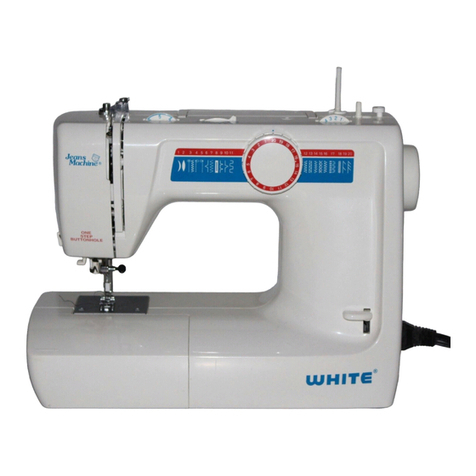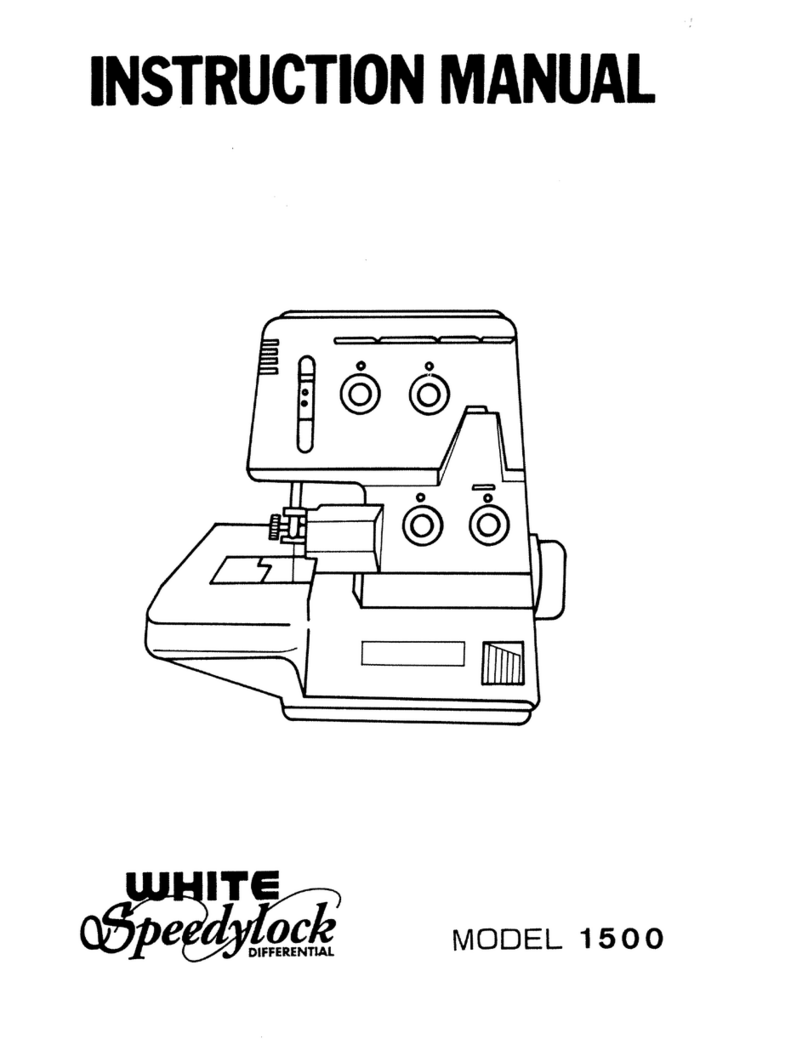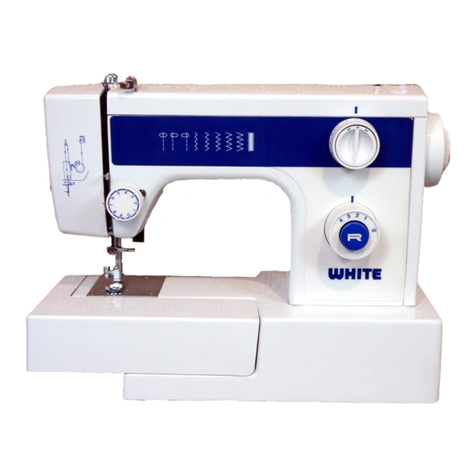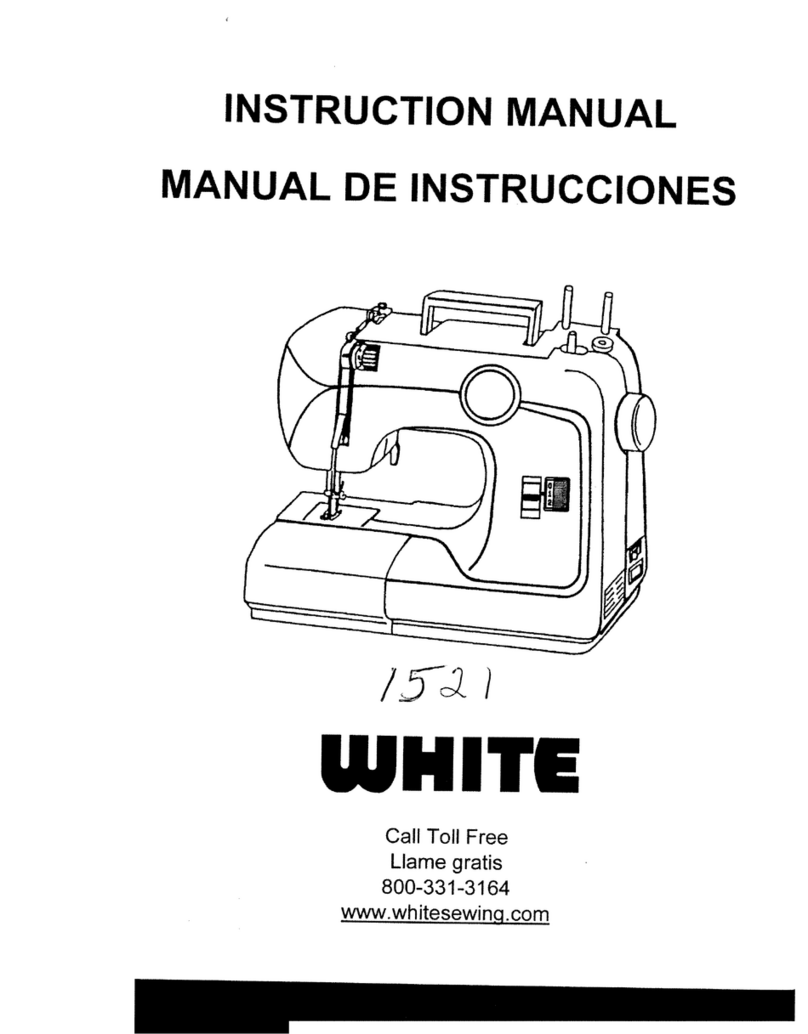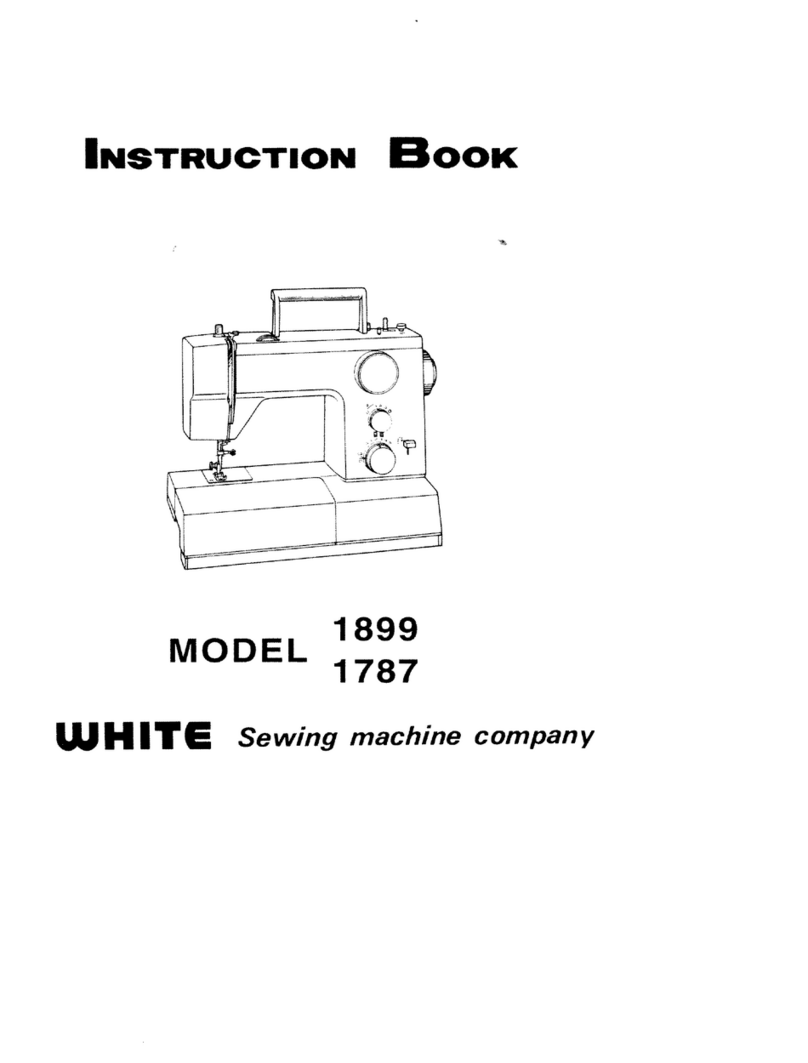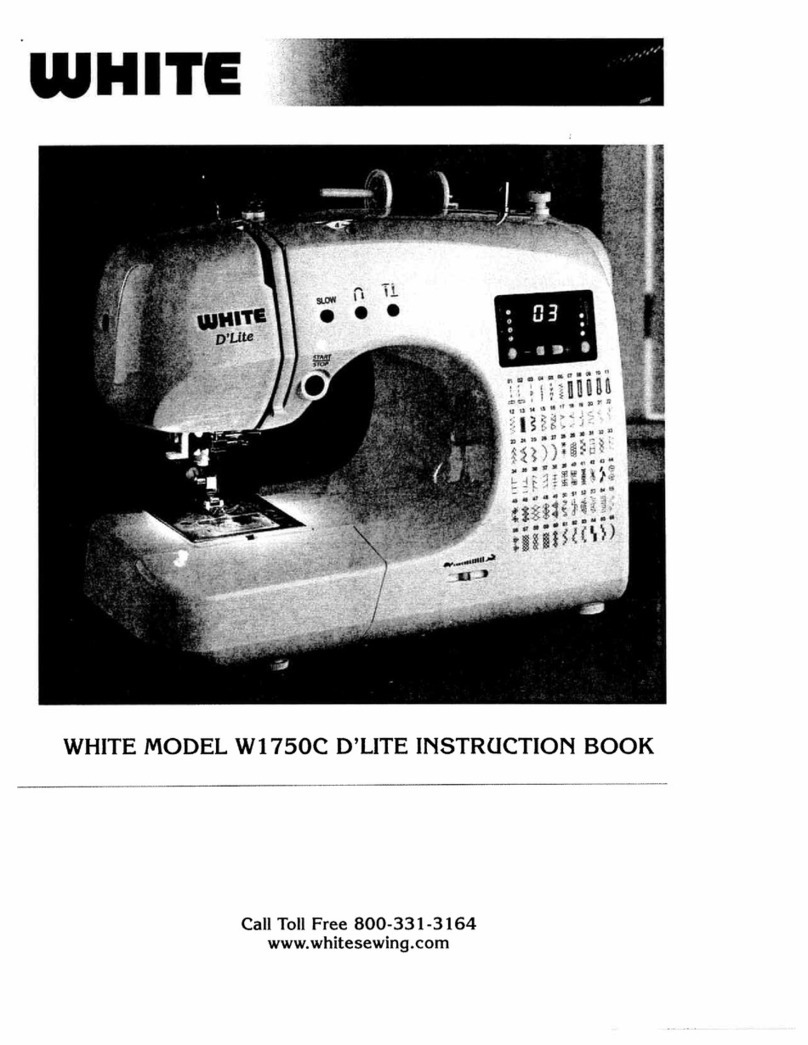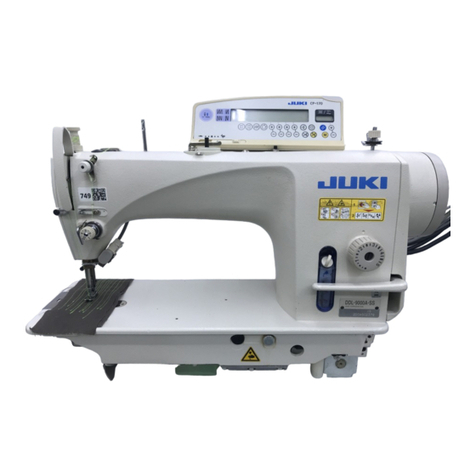White 1268 Operation manual

“1
1
t

You
are
now
the
owner
of
a
new
zigzag
sewing
machine,
the
most
versatile
type
of
its
kind you
can
possess.
Buttonholes,
monogramming, overcasting
and
creative
embroidery
are
done
with
ease
and
speed.
To
aid
you
in
obtaining
the
greatest
performance
from
your
new
machine this
book
on
its
care
and
use has been
written
for
you.
Read
the
instructions
carefully
as
a
thorough
understanding
of
your
machine
will
reward
you
with
many
hours
of
trouble-free,
creative
sewing.
Time-saving
attachments
such
as
rufflers,
binders,
edgestitchers,
cording
feet
and
so
fc.rth
of
complement
the
accessories
furnished
with
your
machine
are
available
from
the store
where
you purchased
your
machine.
WHITE
SEWING
MACHINE
COMPANY.
CLEVELAND
OHIO
44111
WHITE
SEWING
MACHINE
COMPANY,
LTD.
Toronto
16,
Ontario,
Canada

CD
B
D
CD
Wa’rran4’
Certificate
aiid
Re
1
istratioit
for
NAME
OF
DATE
ORISINAL
OF
PURCHASER
PURCHASE
MODEL
I
268
SERIAL
NUMBER NUMBER
AUTHORIZED
DEALER
SIGNATURE
PLACE
POSTAGE
HERE
WHITE
SEWING
MACHINE
COMPANY
11750
Berea Road
CLEVELAND
11,
OHIO
44111

INDEX
Page
Features
and
Parts
2-3-4
Needle
and
Thread Chart
5
Setting
the
Needle
6
Winding
the
Bobbin
6
Threading
Bobbin Case
7
Placing
Bobbin
Case
in
Shuttle
8
Upper Threading
9
Straight
Stitching
10
Changing
Foot
and
Plate
10
Setting
the
Stitch
Length
11
Stitch
Length
Chart
11
Sewing
in
Reverse
11
Adjusting
the
Tensions
11
Adjusting
Pressure
and
Feed
12
General
Sewing
12
Light
Weight
Fabrics
13
Darning
and
Monogramming
13
Preparing
to
Sew
13
Removing
the
Work
14
Creative
Embroiderj
14
Satin
Stitch
14
Adjusting
Stitch
Width
15
Embroidery
Patterns
15
Samples
of
Embroidery
15
Embroidery
With
a
Hoop 16
Darning
16
Page
Making
Buttonholes
17
Sewing
on
Buttons
18
How
to Use
Accessories
19-20-21
Narrow
Hemmer
19
Lace
Trimmed
Hem
19
Lace
Edge
20
French
Seam
20
Flat
Felled
Seam
20
Hand
Rolled
Effect
20
Quilting
Guide
20
Seam
Gauge
21
Care
and
Maintenance
21
Oiling
21-22
Cleaning
and
Oiling
Shuttle
23
Accessories 24
Trouble
Charts
25-26-27
Attachments
29-30-31-32-33-34
Attachment
Foot
30
Edgestitcher
30
Ruffler
33
Binder
3].
Hemmers
32
Darning Spring
32
Cording
&
Zipper
Foot
34
Sewing
on
Zipper
34
Blind
Stitch
Hem
35

2
©
©
©
©
Fig.
1

FEATURES
AND
PARTS
(Front
View)
1.
Pressure
Release
-
Darner
13.
Drop
Feed
Knob
2.
Arm
Thread
Guide
14.
Needle
Plate
-
Seam
Guide
3.
Zigzag
Width
Stops
15.
Cover
Plate
4.
Zigzag
Stitch
Width
Lever
16.
Presser
Foot
5.
Spool
Pin
17.
Attachment
and
Foot
Clamp
Screw
6.
Hand
Wheel
18.
Needle
Clamp
Screw
7.
Wheel Clutch
19.
Thread
Guide
8.
Bobbin
Winder
20.
Tension
Regulator
9.
Stitch
Length
Stops 21.
Thread
Bar
10.
Forward
and
Reverse
Stitch
22.
Light
Switch
Length
Lever
23. Take
Up
Lever
11.
Stitch
Length
Stops
Lock
12.
Bobbin
Winder
Tension

FEATURES
AND PARTS
(Back View)
A
j
I
t
L*26
27
28
Fig.
2
24.
Motor
26.
Presser
Bar
Lifter
25.
“V”
Belt
27.
Thread
Cutter
5
28.
Feed
Dog

5
NEEDLE-THREAD-FABRIC-STITCHING
GUIDE
Machine
Silk
Needle
Stitches
Cotton
Mercerized
or
Fabric
No.
Per
Inch
Thread Thread
Nylon
Extremely
heavy
6
10
tarpaulin,
sacking,
4
to to
Heavy
Duty
canvas,
duck, etc.
8
30
Heavy
upholstery
8
30
fabric,
ticking,
3
to to
Heavy
Duty
denim,
leatherette
10
40
Medium
heavy
drapery
40
fabric,
velveteen,
2
to to
Heavy
Duty
suiting,
felt,
terry,
etc.
12
60
Medium
broadcloth,
12
60
percale,
gingham,
linen,
to
t
50
A
chintz,
taffeta,
sheer
14
80
wool,
shantung,
etc.
Sheer
voile,
lawn,
14
80
dimity,
crepe,
0
to to
50
A
handkerchief
linen,
16
100
plastic
film,
etc.
(Plastic
film)
8
to
10
Very
sheer
chiffon,
16
100
batiste,
lace,
organdy,
00
to
to
50
A
ninon,
net,
marquisette,
etc.
20
150

6
SETTING
THE
NEEDLE
See
Fig.
3.
Raise
the
needle
bar
A
to
its
highest
point,
turning
wheel
toward
you
by
hand.
Then loosen
the
needle
clamp
screw
B
and
the
needle
can
be
inserted
into
clamp
C.
Place
needle
(flat
side
to
right)
in
the
needle
clamp
and
push
it
upward
as
far
as
it
will
go
into
the
needle
clamp
hole,
tightening
the
needle
clamp
screw
securely
with
a
screw
driver.
After
changing
needle
make
one
complete
revolution
of
balance
wheel
by
hand
to
be
sure
the
needle
is
in
the
correct
position.
HOW
TO
WIND
THE
BOBBIN
Disengage
the
hand
wheel
(4,
Fig.
4)
from
the stitching
mecha
nism
by
turning
the clutch
5
toward
you
or
counterciock-wise.
Place
a
spool
of
thread
on
spool
pin,
lead
thread
through
the
upper
thread
guide
on
the
arm
and
down
through
the
tension
disc
(A
Fig
5)
at
the
base
of
the
machine.
Run
end
of
thread
through
a
hole
in
the
bobbin
edge
and
place
bobbin
B
on
spindle
of
bobbin
winder
C,
fitting
the
notch
on
bobbin
over
small
pin
on
spindle.
Push
bobbin
winder
pulley
against
hand
wheel.
Hold
thread
end
loosely
and
start
machine
slowly.
Bobbin
will
stop
winding
when
it
is
filled.
Turn
clutch
away from
you
until
sewing
mechanism
is
again
engaged
so
that
needle
moves
when
you
turn
the
hand
wheel.
Break
off
loose
thread
end
used
to
start
the
winding.
Fig.
3
F
LAT
R
00
V
ED
SI
Fig.
5
Fig. 4

7
THREADING
THE
BOBBIN
CASE
RFACI
SID
Step
1
(illustrated
in
Fig.
6).
Hold
bobbin
case
between
thumb
and
forefinger
of
left
hand,
so
that
the
slot
in
the
edge
of
the
bobbin
Fig.
6
case
is
on
top.
Take
the
bobbin
between
thumb
and
forefinger
of
right
hand
so
that
the
thread
on
top
leads
from
left
to
right
Step
2.
Insert
bobbin
into
bobbin
case,
pull
the
thread
into
the
slot
of
the
Fig.
7
bobbin
case
as
shown
in
Fig.
7,
and
draw
it
under
the
tension
spring
and
into
the
fork-shaped
opening
rom
hen
of
the
spring
as
shown
in
Fig.
8.
Fig.
8
I

8
PLACING
BOBBIN
CASE
IN
SHUTTLE
A
Open hinged
cover
plate
left
of
the
needle.
(See
15,
Fig.
1)
Hold
the
bobbin
case
latch,
(D),
E
Fig.
9,
between
the
thumb
and forefinger
of
the
left
hand,
with
at
least
three
inches
of
thread
running
from
the
top
of
the
bobbin
case
to
the
right.
Insert
and
center
the
bobbin
case
on
the
stud
of
the
shuttle
body,
(C).
Be
sure
the
bobbin
case
finger,
(E),
enters
the
shuttle
race
notch,
(A).
Press
the
bobbin
case
(B)
into
the
shuttle
as far
as
possible
until latch
catches
on
the
center
post
of
the
Fig.
9
shuttle.
THEN
release
the
bobbin
case
latch,
(D).
Press
bobbin
case
again
after
latch
has
been
re-
F
leased
to
make
sure
the
bobbin
case
is
locked
securely
in
place.
Close
the
cover
plate.
I
I
I
C
Fig.
10

9
UPPER
THREADING
1.
Turn
the
balance
wheel toward
you
to
raise the
take-
up
and
needle
to
their highest
position.
2.
Place
spooi
of
thread
on
spool pin.
3.
lead
thread
under
arm
thread guide
A
and
by
a
cir
cular
motion
with
your
left
hand
lead
thread
through
guide.
4.
down
and
around
one
set
of
tension
discs
B
from
right
to
left.
5.
into
notch
on
the right
hand
side
of
check
spring
C
Fig
11
over
threaded
discs.
6.
under
thread
guide bar
and
into
guide
D.
7.
Up
into
take-up
lever
from
right
to left.
8.
Down
through
guide
in
thread
bar
D
again.
9.
Into
guide
inside
face plate.
10.
Through
needle
clamp
guide
and
into
needle
from
front
to
back
pulling
three
to
four
inches
of
through needle.
Hold
the
end
of
upper
thread
loosely
and
turn
hand
wheel toward
you
until
the
needle
goes
all
the
way
down
and
comes
back
up.
A
loop
(Fig.
11)
will
be
formed
over the
upper
thread
which
then
can
be pulled
out
straight.
Place
both
thread
ends
under
the
slot
of
the
presser
foot
and
draw
toward
the
back
of
the
machine,
leaving both
threads
three
or
four
inches
long.

10
STRAIGHT
STITCHING
For
straight
sewing
on
fine fabric
or
very
soft
material,
you
may
want
to
use
the
straight
stitch
presser
foot
and
the
straight
stitch
needle
plate
which
are
included
in
your
accessory
box.
Both
have
narrow
needle
slots.
Changing
the
Foot
and
Plate.
To
change
presser
foot
(16
Fig.
1)
loosen
thumb
screw
(17,
Fig.
1)
and
remove
zigzag
foot.
Replace
with
hinged
narrow
foot
and
tighten
screw securely.
To
change
needle
plate
(14, Fig.
1)
remove
it
with
cover
plate
from
machine.
Turn
assembly
wrong side
up.
Hold
needle
plate
in
left
hand
and
cover
plate
in
right
(Fig.
12-A)
Slip
upper
pin
on
cover
plate
out
of
groove
on
needle
plate,
and
pull
upper
portion
of
cover
plate
away.
Then
lower
pin
can
be
separated
from
groove
as
the
tongue
on
cover
plate
slips
out
of
the
spring
latch
on
needle
plate.
To
attach
cover
plate
to
straight
stitch
plate,
again
hold
assembly
wrong side
up.
Holding
cover
plate
in
right
hand
at
a
slight
upward
angle,
slide
lower
pin
into
groove,
then
lift
cover
plate
to
insert tongue
into
opening
of
spring
latch.
Upper
pin
will
then
slide
easily
into
groove.
Put
plates
on
machine
and
fasten
securely
with
needle
plate
screws.
Be
sure
to
set
the
stitch
width
at 0
or
the
needle
will
break
in
striking
the
foot
or
plate.
Adjust stops
3
to
hold
zigzag
lever
4
in
0
position.
4
1”
Fig.
I
2-A
Fig.
12-B

11
SETTING
THE
STITCH
LENGTH
Forward
and reverse
stitching
are
both
regulated
by
Lever
10,
Fig.
12-B.
To
adjust
the
stitch length,
loosen
screw
11
and
move
lever
10
downward
to
increase
the
stitch
length
or
upward
to
shorten
it.
Tighten screw
11,
this
will
set
the
stops
for
both
forward
and
reverse
stitching.
STITCH LENGTH CHART
(Approximate)
Figures
on
indicator
—
0
1
2
3
4
5
Number
of
stitches
per
inch
No
Feeding
55 25
13
86
SEWING
IN
REVERSE
When
you
wish
o
sew
in
reverse
to
tie
the
threads
at
the
beginning
or
the
end
of
a
seam,
raise
Levers
10,
Fig.
12-B,
up
as
it
will
go.
The
machine
will
sew
in
reverse
until
Lever
10
is
returned
to
its
original
position.
ADJUSTING
THE
TENSIONS
Always
adjust
the
upper
tension
with
the
presser
foot
down,
s
the
tension
is
released
when
it
is
raised.
To
increase
the
tension
on
the
upper
thread, turn
dial
(Fig.
13)
to
the
right,
or
(iockwise.
To
decrease,
turn
to
the
left.
The
higher
the
number
)fl
the
dial
the tighter
the
tension.
Before
adjusting
lower
tension
be
sure
that
the
machine
is
threaded
properly.
When
necessary
to
change
the
bobbin
tension,
turn
small
:crew
(Fig.
14)
on
side
of
the
bobbin
case
clockwise
to
tighten,
counterclockwise
to
loosen.
Fig.
13

12
When
the
upper
and
under
tensions
are properly
balanced,
a
perfect
stitch
will
be
formed
with
both
threads
interlocking
in
fabric
(Fig.
15).
When the
upper
tension
is
too
tight,
the
lower
thread
is
pulled
up
over
the
upper
thread
which
is
lying
flat
on
the
fabric
(Fig.
16)
When
the
upper
tension
is
too loose
the
upper
thread
forms
ioops
over
the
lower
thread
lying
flat
on
the
fabric
(Fig.
17).
ADJUSTING
PRESSURE
Fig.
14
AND
FEEDING
OF
FABLIC
GENERAL
SEWING.
Usually for
straight
sewing
and
zigzag
stitching,
the
pressure
bar
cap
or
darner
release,
21,
Fig.
18,
is
at
its
lowest
position
and
the
drop
feed
knob
is
turned
to
NORM.
position,
Fig.
19.
Fig.
15
__
___
___
___
Fig.
16
__
__
__
21
Fig.
17
fl<Jj
1.
Fig.
18
Fig.
19

13
SEWING
THIN
OR
LIGHT
WEIGHT
FABRICS.
When
lighter
pressure
is
required
to
sew
satisfactorily
on
thin
silk
or
filmy
material,
the
pressure
cap should
be
about
halfway
down.
Release
all
the
way
by
pressing
the
snap
lock,
A.
Fig.
20.
nd
then
press cap
B
down
again
to
halfway
spot.
Lower
the
feed
lightly
by
turning
the
red
arrow
on
the
knob
to
EMBR.
Position
DARNING
AND
MONOGRAMM1NG.
In
order
to
move
the
fabric freely
in
any
direction
for
darning,
mending
and
certain
kinds
of
free-hand
embroidery,
release the pressure
cap
B
com
pletely
by
pressing
down
on
the
snap
lock,
A,
Fig.
20.
Turn
the
knob
to “DOWN”
position,
which
drops
the
feed
well
below
the
cap
needle
plate.
To
return
feed
to
normal,
return
knob
to
“HIGH”
to
PREPARING
TO
SF’W
Have
take-up
lever
at
highest point before starting
to
sew.
Do
not
try
to
help
the
feeding
by
pulling
the
material
as
this
may
deflect
the
needle and
cause
it
to
break.
NEVER
run machine
without
material
under
presser
foot.
Place material
and
threads
in
position
under
the
presser
foot
and
lower
the
presser
foot.
Turn
the hand
wheel
toward
you
until
the
needle
is
at
its
highest
point.
You
are
now
ready
to
begin
sewing.
By
having the
needle
at
its
highest
point,
it
is
not
necessary
to
touch
the
hand
wheel
to
start
the
machine.
You
merely
press the
control.
The
speed
of
the
machine
is
regulated
by
increasing
or
decreasing
the
amount
of
pressure
exerted
on
the
control.
Fig.
20

14
REMOVING
THE
WORK
Be
sure
to
stop
the
machine
when
the
thread
take-up
lever
and
needle
bar
are
located
at
the highest
position.
Now
raise
the
presser
foot
and
draw
the fabric
back
and
to
the
left, Fig.
21-A
and
B,
and
pass
the
threads
over the
thread
cutter.
Pull
down
slightly,
holding
thread
in
both
hands,
so
as
not
to
bend
the
needle.
Leave
the
ends
of
thread
under
the
presser
foot.
CREATIVE EMBROIDERY
Be
sure
zigzag
presser
foot
and
zigzag
needle
plate are
in
place.
The
satin
such,
Fig.
22,
which
is
really
just a
very
short
zigzag
stitch,
and
the
basis
for
Fig.
22
most
embroidery,
is
obtained
by
setting
the
stitch
length
as
near
0
as
possible
without
stopping the
feeding
action.
The
width
may
be
set
anywhere
from
just
past
0
to
the
widest,
4.
F
--
--------‘
Fig.
21-B

15
Adjusting
the
Stitch width
To
stitch
continuously
at
one width
of
zigzag
stitching,
lock
stops
3
(Fig.
12B)
EO
that
pointers
meet
on
width
chosen. Should
you
wish
to
move
freely
between
any
two
widths,
such
as
2
and
4,
in
doing
free
hand
embroidery
or
buttonholes,
slide
stops
to
0
and
4,
then
move
zigzag
width
lever
to
the
right.
Set
left
stop
at
desired
width. Then
move
lever
to
the
left
and
set
the
right
stop
at
width
desired.
To
move
stops,
turn
knob
to
left
to
loosen
and
to
right
to
tighten.
Embroidery
Patterns
With
the machine
set
for
a
short
stitch length,
different
designs
can
be
made
by
swinging
the stitch width
or
zigzag
lever
back
and
forth
between
0
and
4or
any
other
combination
of
widths.
Try
setting
the
locks
at
1
and
4,
2
and
3,
etc.
Set
a
rhythm
for
yourself
and
then
proceed.
After
a
while
you
will
become
quite
skillful,
varying
your
designs
by
the
speed
of
the
machine,
stitch
length
and
width
and
the manipulation
of
the
lever.
SAMPLES
OF
CREATIVE EMBROIDERY
A.
Sew
a
few
stitches
at
4
width,
then
quickly move
lever
back
to
0
for
a
short
period.
Count,
if
necessary,
to
A
establish
a
rhythm.
B.
Set
stops
at
2
and
4,
then
move
lever
slowly
between
B
settings,
operating
machine
rather
fast.
C.
Set
stops
at
1
and
4.
Gradually
move
lever
from
1
to
C
4,
then
snap
it
back quickly
to
L
AAMAAAAA
D.
Set
th
stops
at
4,
stitch
length
at
4.
Do
a
few
zigzag
D
vvvvvv
F
stitches,
drop
feed
for
3
or 4
stitches,
then
raise
it
Fig.
23
again.
By
operating
the
feed
knob rhythmically
it
is
not
necessary
to
count
stitches.

16
EMBROIDERING
WITH
A
HOOP
It
is
easy
to
follow
a
stamped
design
or
to
work
free
hand
when
embroidering
or
monogramming.
(See
Fig.
24).
Release
the
pressure
from
the
foot
by
pressing
down
the
snap
lock
on
the
darner.
Turn
the
drop
feed
knob
to
EMBR.
position
(see
Fig.
19).
Stretch
the
fabric
in
an
embroidery
hoop,
and
place
under
the
needle
after
removing
the
presser
foot.
Set
the
stitch
width
at
the
size
you
prefer
and
lower
the
presser
bar
lifter.
Then
operate
the machine
at
a
rather
high
speed
while
moving
the
hoop
slowly
with
both
hands.
Word
carefully
and be
sure
to
keep
fingers
out
of
the
path
of
the
needle.
DARNING
Release
pressure
from
foot
and
drop
feed
as
directed
above.
Place fabric
to
be mended
under
foot,
and
stitch
around
hole,
moving
the
fabric
firmly
and
slowly
in
any
direction,
To
fill
in
the
hole,
stitch
from
center
outward,
completing
and
stitching
in
fabric.
Fig.
24

17
MAKING BUTTONHOLES
First,
mark
the
beginning
and
end
of
the
buttonhole
on
fabric
with
a
basting
line
or
tailor’s
chalk.
Make
one
on
scrap
fabric
(following
directions
below)
to
be
sure
machine
adjustments
are
‘orrect.
1.
Replace
presser
foot
with
buttonhole
foot
which
is
grooved
deeply
underneath
to
prevent
piling
up
of
thread.
(See
Fig.
25).
2.
Lock
the
stitch
width
at
2
and
set
the stitch
length
near
0.
3.
Lower
needle
carefully
into
the
mark
on
fabric
indicating
the
beginning
of
buttonhole.
Stitch
to
the
mark
for
the
end
of
the
buttonhole,
step
1,
Fig.
26,
stopping
machine
with
needle
in
fabric
at
right
side
of
stitching.
4.
Lift
the
presser
foot
and
using
the
needle
as
a
pivot,
turn the
fabric
end
for
end.
5.
Lower
presser
foot
and
turn
hand
wheel
just
enough
to
raise
needle
out
of
fabric.
6.
Drop
feed
all
the
way
down
and
move
zigzag
lever
to
4.
While
holding
the lever
at
4
width,
take
five
or
six
stitches
to
from
bar
tack,
step
2,
Fig.
26.
7.
Raise
needle
out
of
fabric
and
return
feed
to
“HIGH”
position
and
return
stitch
width
lever
to
2.
8.
Stitch
second
side
of
buttonhole, step
3.
9.
Make
bar
tack
by
repeating
5
and
6
above
(step
4).
10.
Return
stitch
width
to
0
and
take
two
or
three
stitches
Fig.
25
riI
q
C
ravelling.
Cut
the
buttonhole
opening
with
a
seam
ripper,
being
careful not
to
cut
the
stitchig.
Fig.
26
to
fasten
bar
threads
and prevent
Table of contents
Other White Sewing Machine manuals
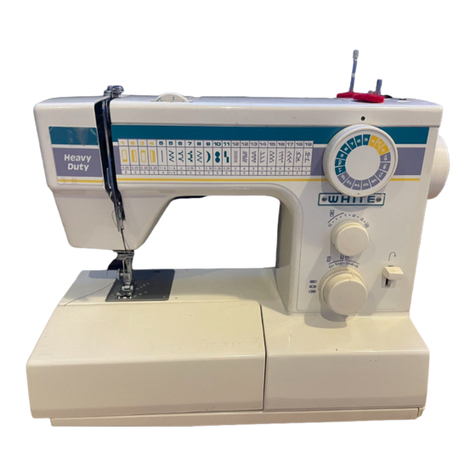
White
White 1927 User manual

White
White 535 Operating instructions
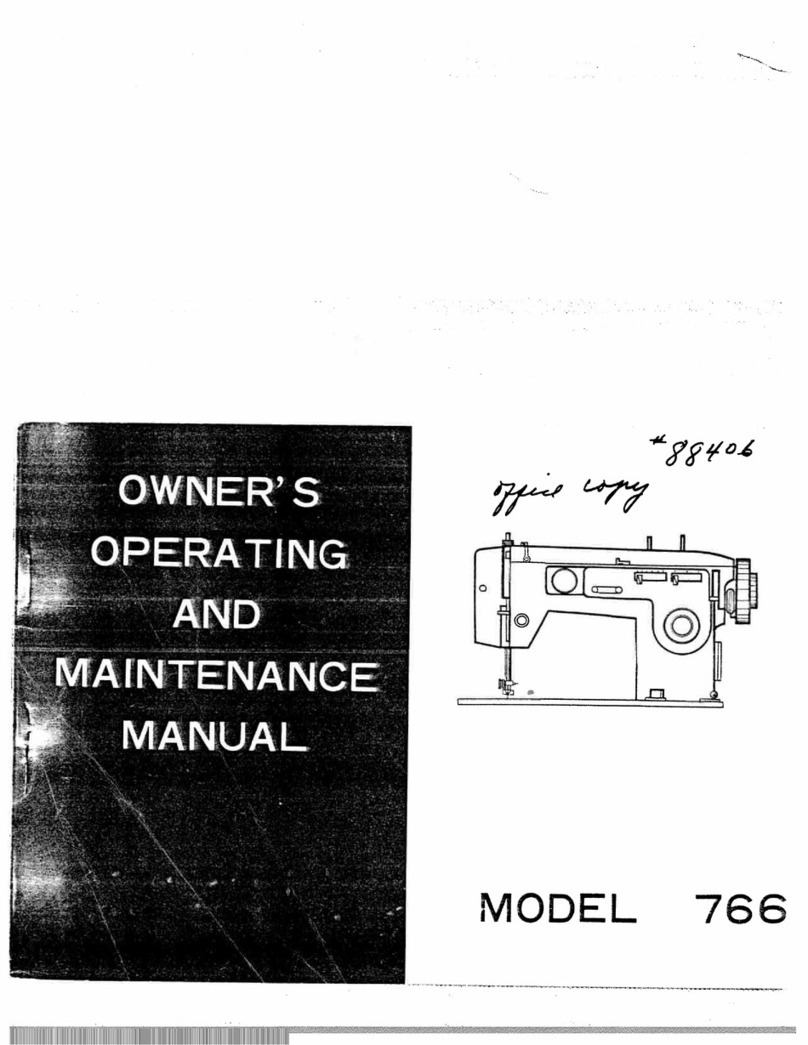
White
White 766 Operation manual
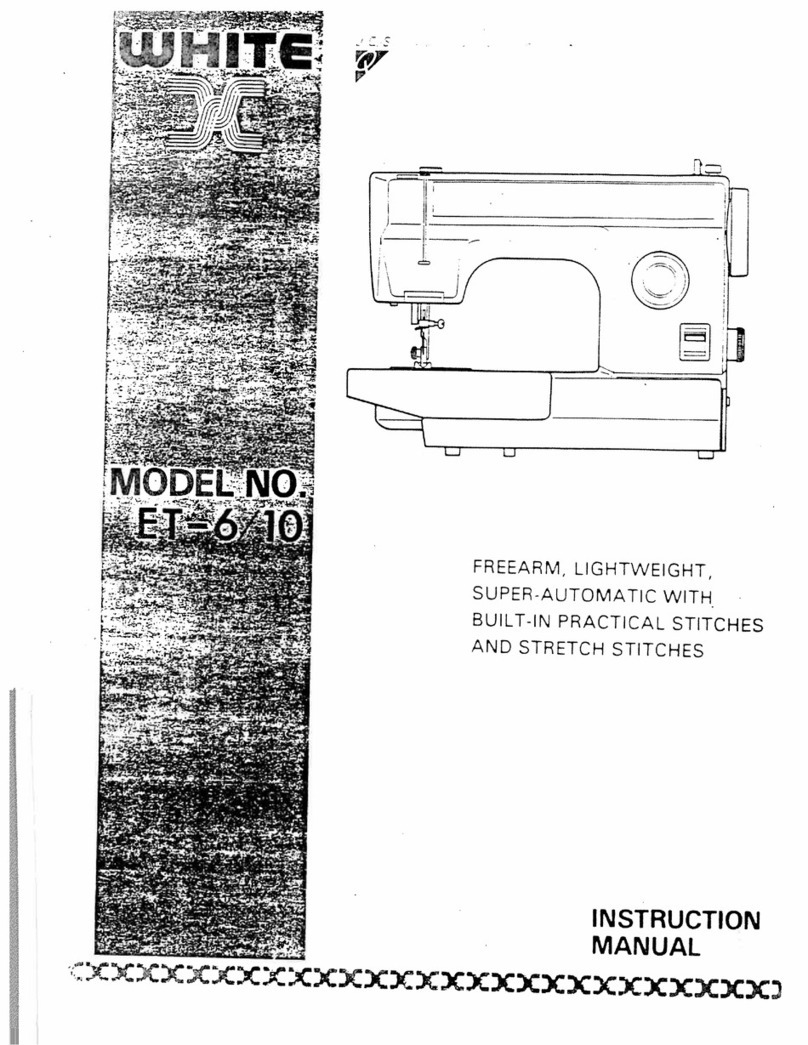
White
White ET-6/10 User manual
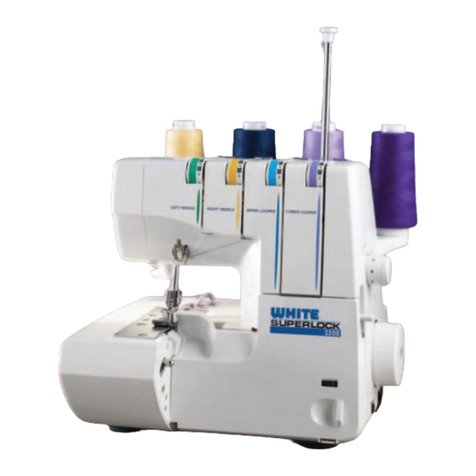
White
White W2500 User manual
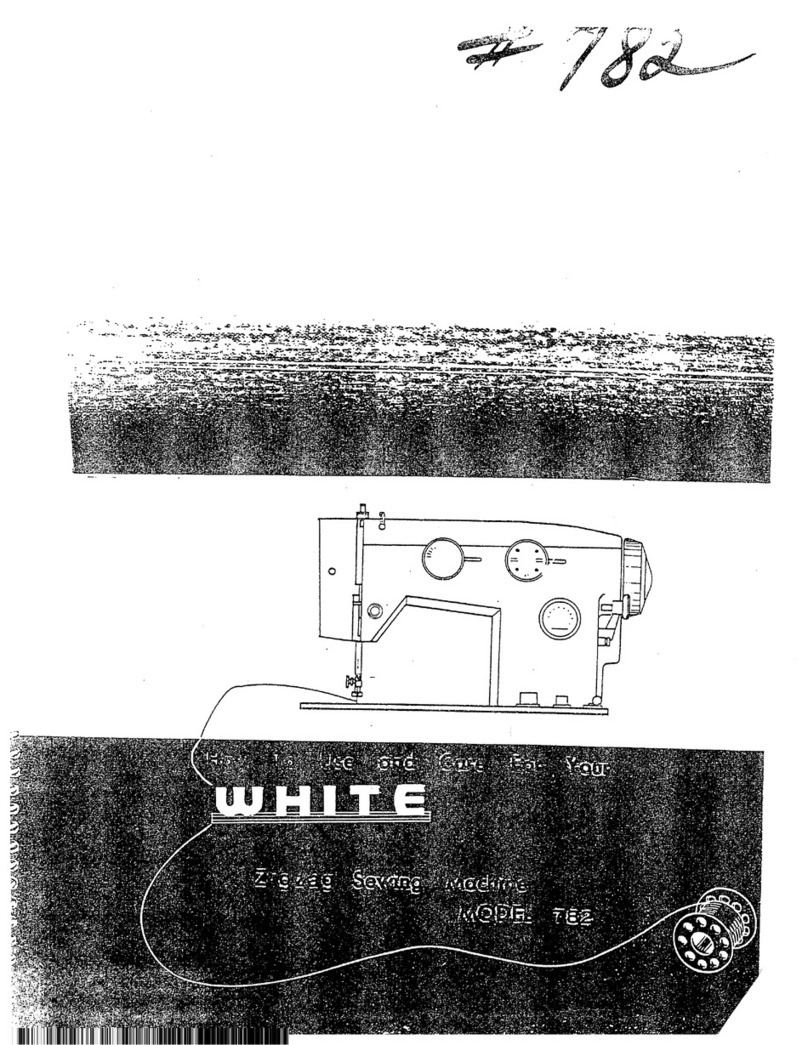
White
White 78-2 Installation and operation manual
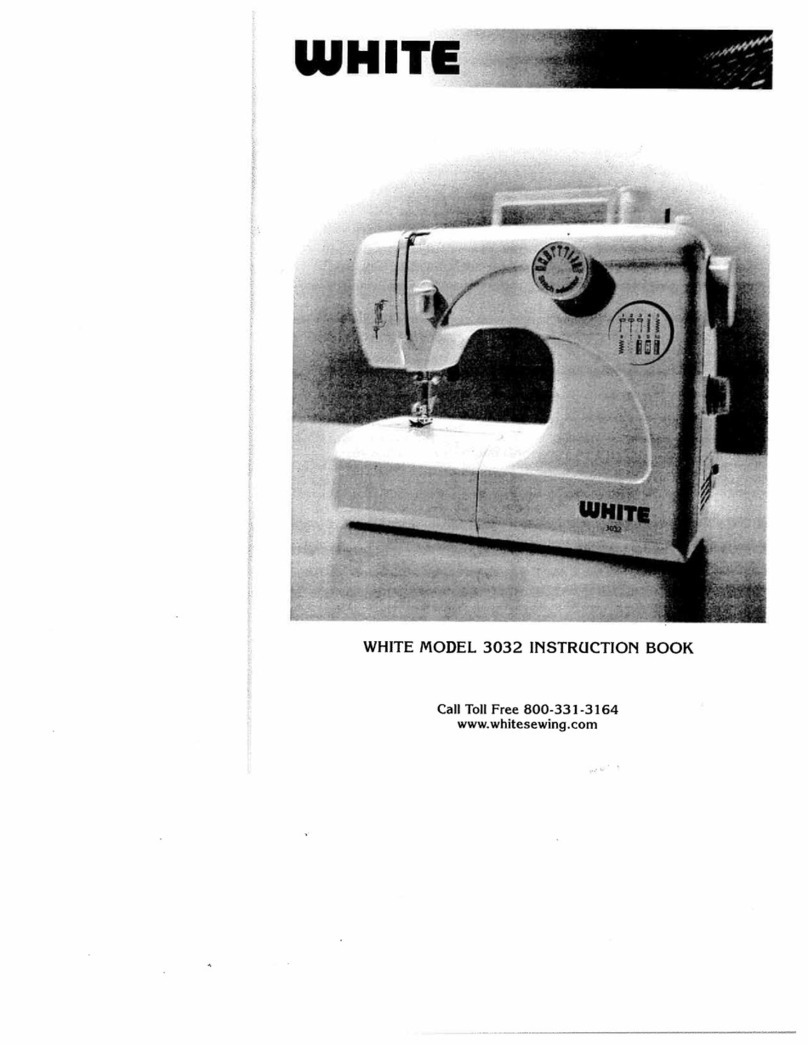
White
White 3032 User manual
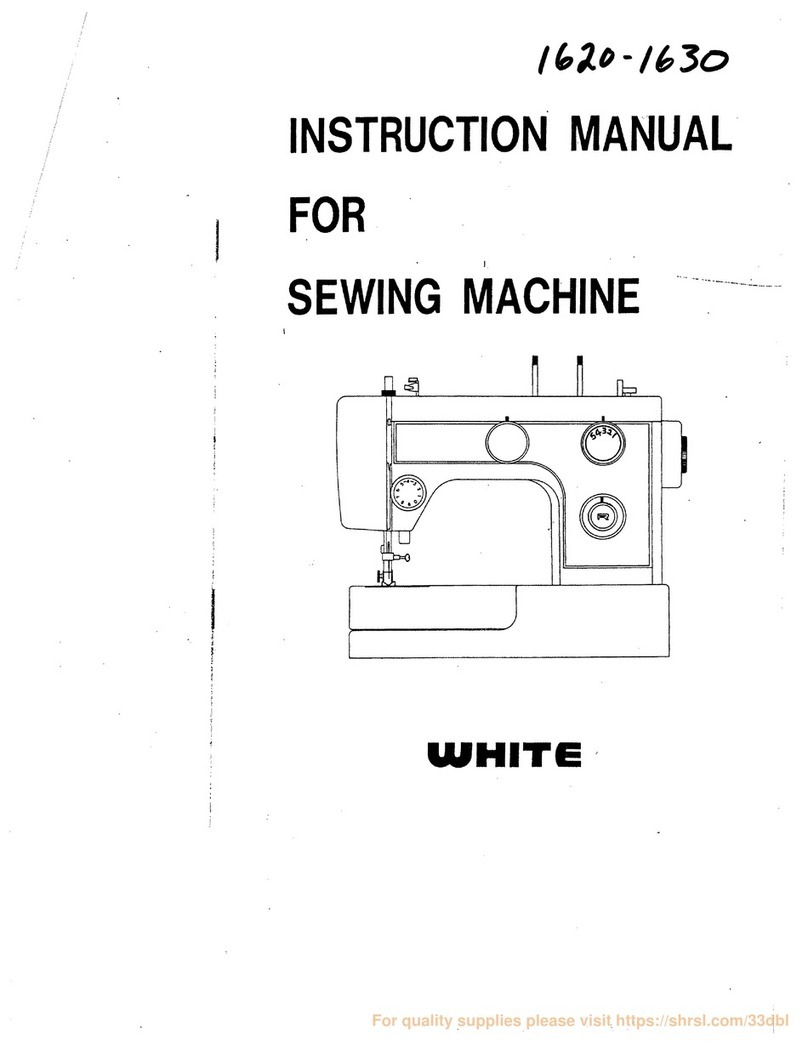
White
White 1620 User manual

White
White 1750 User manual
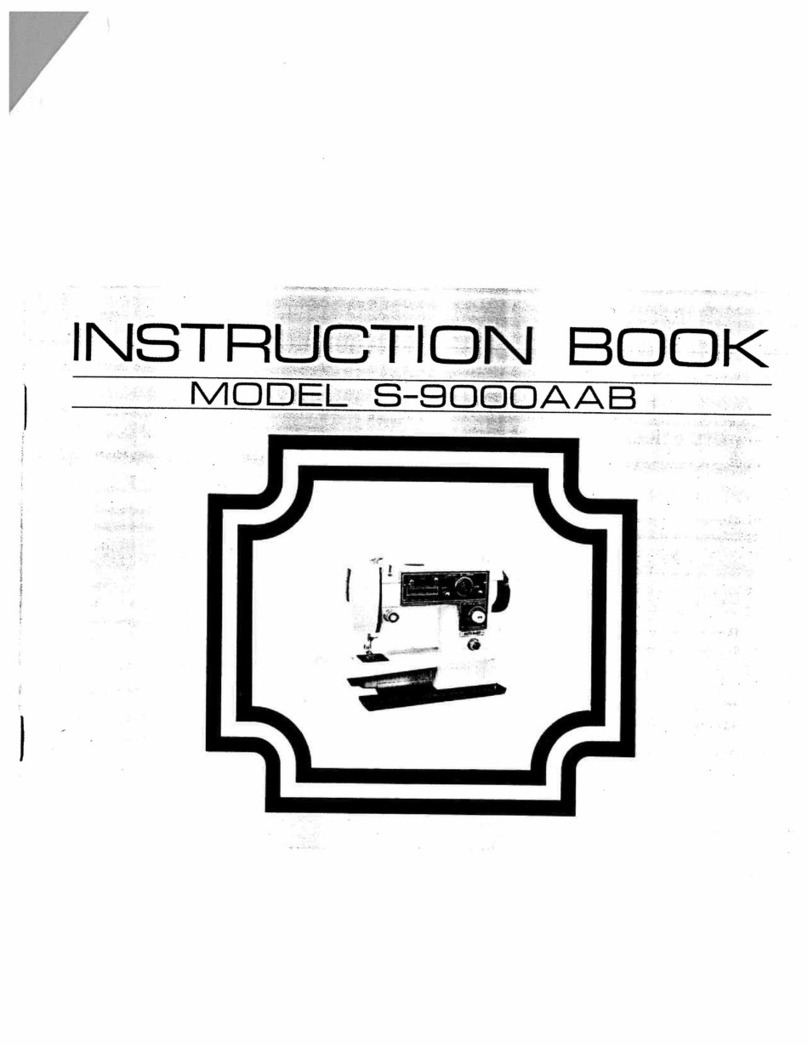
White
White S-9000AAB User manual
